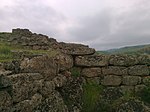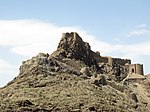Maymun-Diz
| Maymun-Diz | |
|---|---|
میمون دژ | |
 | |
| General information | |
| Status | Demolished |
| Type | cave-fortress |
| Location | disputed; near Alamut Castle |
| Country | Iran |
| Inaugurated | 1097 |
| Demolished | November 1256 |
| Client | Nizari Ismaili state |
| Technical details | |
| Material | plaster, gravel |
Maymūn-Diz (
The fortress was surrendered by Imam
History
The date of the (beginning of the) construction by the Nizari Ismailis is variously given as 1097 (per
After the
Apparently, the Mongols were hesitant to push the siege of Maymun-Diz, and were persuaded to accept some sort of compromise.[10] As winter was approaching, the besieging Mongols faced supply problems due to the difficulty of finding fodder for their horses.[12] On 19 November 1256, Khurshah with a group of notables left the fortress and surrendered to Hulagu Khan. Considering how well-fortified and well-provisioned Alamut was, the Mongols welcomed the surrender.[10][11] A group of Nizaris kept fighting in a last stand in the "qubba" (a supposedly high domed structure within the fort) and were killed.[13] Maymun-Diz was subsequently destroyed and its inhabitants were massacred. This is traditionally considered the date of the disestablishment of the Nizari Ismaili state.[11][10]
See also
References
- ^ Persian pronunciation: [mei̯mʊnˈdez]; also میمون دژ [mei̯mʊnˈdeʒ]. The first component means both "monkey" and "blessed", and is variously transliterated as maymun (maymūn), meymun (meymūn), maimun (maimūn), meimun (meimūn), meymoon, meimoon. The second component means "fortress", and is variously transliterated as dez, diz, dezh, dizh, dej, dij.
- ISBN 9789646350779.
- ISBN 978-1-59584-307-4.
- ISBN 978-964-6053-24-3.
- ISBN 978-964-6053-24-3.
- ^ "Construction of Maimundiz". www.ismaili.net. Retrieved 3 April 2020.
- ^ ISBN 978-0-253-35385-6.
- ISBN 978-90-04-09738-4.
- ^ ISBN 978-1-86019-407-8.
- ^ ISBN 978-0-521-06936-6.
- ^ a b c Daftary, Farhad. "The Mediaeval Ismailis of the Iranian Lands | The Institute of Ismaili Studies". www.iis.ac.uk. Retrieved 31 March 2020.
- ISBN 978-3-7001-6103-5.
- ^ Pickthall, Marmaduke William; Asad, Muhammad (1967). Islamic Culture. Islamic Culture Board.




















